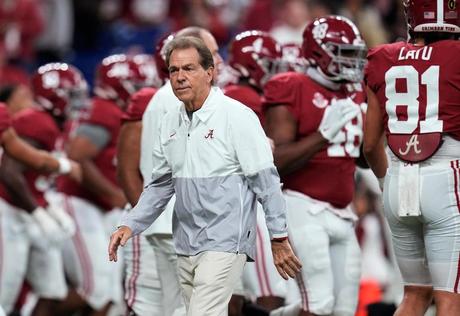
By RALPH D. RUSSO
TUSCALOOSA, Ala. - Nick Saban's willingness to adapt and often be a catalyst for change in college football, both on and off the field, propelled Alabama to six national championships in 13 seasons.
The 70-year-old coach is confident his program will continue to thrive in this new era of college athletics, with players having more opportunities to make money than ever before and more power to determine where they go. are playing.
But the current state of college football worries Saban.
"I don't think what we're doing right now is a sustainable model," Saban told The Associated Press in a recent interview.
It's a common theme among coaches these days, with Clemson's Dabo Swinney and Southern California's Lincoln Riley among the most prominent who echoed Saban's sentiments. The combination of self-directed athletes and easily accessible paydays is changing the way coaches do business.
The uncertainty comes with the NCAA in a weakened state following last year's Supreme Court loss and amid dramatic restructuring. Schools and the NCAA itself would prefer federal legislation to regulate how athletes are compensated for their names, images and likenesses, but when that might happen and in what form is unknown.
It has raised concerns about the huge sums of money circulating in and around college athletics, including brazen entities called collectives made up of well-heeled donors whose donations have traditionally funded everything from lavish facilities to buyouts. of multi-million dollar licensed coaches around the Power Five conferences. .
"The concept of name, image and likeness was that players could use their name, image and likeness to create opportunities for themselves. That's what it was," Saban said. "So the last year, in our team, our guys probably won as much or more than anyone in the country."
Paying a player to attend a particular school is still a violation of NCAA rules, but NIL deals have quickly become intertwined with recruiting - both high school prospects and the growing number of transfers academics.
"But it creates a situation where you can basically buy players," Saban said. "You can do it in recruiting. I mean, if that's what we want college football to be, I don't know. And you can also ask players to go to the transfer portal to see if they can get more somewhere other than you.
Riley told reporters last week that NIL had "completely changed" recruiting.
"I think anybody who cares about college football isn't really happy with that because that wasn't the intention," said Riley, who is in his first season in Southern California after five years in Oklahoma. . "And I'm sure at some point there will be a market correction if you will, with recruiting."
It's hard to know exactly what's going on with recruiting and the NIL, as it mostly happens outside the realm of the schools and the NCAA between parties with no obligation to publicly disclose the agreements.
A NIL contract drawn up for an unidentified top recruit could be worth up to $8 million. Earlier this year, Texas A&M coach Jimbo Fisher was angered by rumors that the Aggies used millions of NIL money to sign the National Consensus No. 1 recruiting class for 2022.
Mississippi coach Lane Kiffin is among those worried about recruiting disputes between emboldened coaches and boosters,
"I think there are going to start to be potential issues of donors and collective groups saying they want player A from their area. And the coaching staff wants Player B," Kiffin told AP.
Swinney said ESPN's major college football needed a "complete blowout" that could result in something more like professional football.
"I think you will have 40 or 50 teams and a commissioner and here are the rules," he said.
Saban said he was not against players getting paid and having more freedom to change teams.
"We now have an NFL model without a contract, but everyone has free agency," Saban said, echoing a comparison made by Kiffin.
"It's good for the players to get money. I totally agree. I'm not against it. But there also has to be some responsibility on both sides, which one could call it a contract. For you to have the opportunity to develop people in a way that will help them be successful," Saban said.
Saban, college football's highest-paid coach with a salary of nearly $10 million last season, said the balance of power in sports could tip toward schools with the wealthiest rosters.
"So you're going to have to implement changes, some kind of a way to always create a level playing field," he said. "And there is no salary cap. So whichever school decides to pay the most has the best chance of having the best team. And it was never college football either.
Saban would prefer Alabama to guarantee a fixed amount of money for each player who plays football for the Crimson Tide.
"We give everyone the same medical care, the same school support, the same food service. Same purse. So if we're going to do that, then everyone will benefit as well. I'm not going to create a caste system in our team," Saban said.
LSU coach Brian Kelly supports a similar model, with players agreeing to give up some NIL rights for a base amount of compensation as well as the ability for a school to help build an individual's brand.
"And we have the best NFT," Kelly added, referring to popular digital collectibles. "Who can't sell Mike the Tiger? "
Saban isn't worried about the changing landscape derailing his dynasty. Alabama had more players on NFL rosters (53) than any school at the start of last season. The Tide's personal and professional development track record should remain attractive to top players, though perhaps not as much as in the past.
Saban agrees with that.
"I know we have to adapt to this," Saban said. "You're going to have kids saying, 'Well, I can get a better deal going somewhere else,' and they'll go there. But you're also going to have people who see the light and say, 'Yeah, they have a good history of player development. They have a good history of people development, they have a great graduation rate, and that value is more important.
"And they distribute money to everyone in the organization."

